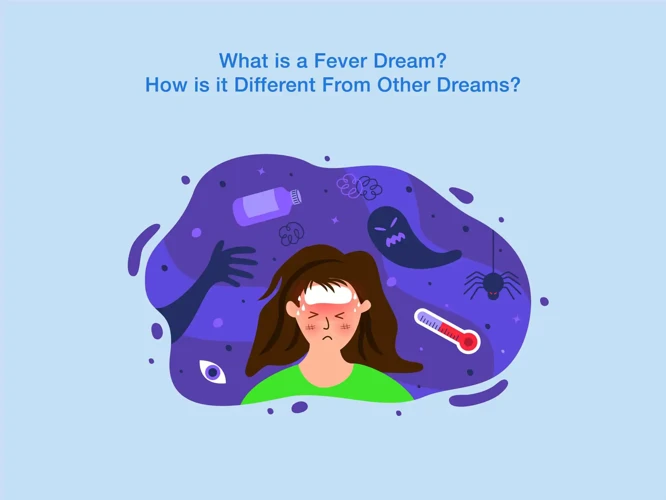Fever Dreams: What Do They Mean and How to Interpret Them – Have you ever woken up from a disturbing dream that left you drenched in sweat? Fever dreams are not like your typical dreams; they occur when your body temperature is elevated due to illness or other factors. These vivid, intense dreams can leave you feeling perplexed and in need of answers. In this article, we will explore the definition of fever dreams and their unique characteristics. We will delve into the causes of these dreams and discuss how they differ from normal dreams. We will provide insights into interpreting and understanding the symbolism in fever dreams. Finally, we will discuss common themes in these dreams and offer actionable ways to manage them. Join us on this insightful journey through the world of fever dreams.
What Are Fever Dreams?

Fever dreams, also known as pyrexial dreams, are a unique type of dream that occurs when a person’s body temperature is elevated due to illness or other factors. These dreams can be extremely vivid and intense, often leaving the dreamer feeling perplexed and unsettled upon awakening. Unlike normal dreams, fever dreams are influenced by the heightened metabolic activity and physiological changes that come with a fever. They may be characterized by bizarre imagery, distorted perception of reality, and intense emotions. Understanding the nature of fever dreams can provide valuable insights into the inner workings of the human mind during times of illness. While fever dreams can be unsettling, they offer a fascinating window into the complex relationship between our physical state and our subconscious mind’s ability to generate fantastical narratives.
Definition of Fever Dreams
The definition of fever dreams refers to a specific type of dream that occurs when a person’s body temperature is elevated due to illness or other factors. These dreams typically arise during episodes of fever and are characterized by intense and vivid hallucinations that can be both strange and unsettling. The content of fever dreams often deviates from the individual’s normal dreaming patterns and may involve surreal scenarios, distorted perceptions, and heightened emotional experiences. The dreamer may encounter unusual creatures, fantastical landscapes, or even experience sensations that are not present in waking life. Understanding the definition of fever dreams can help differentiate them from other types of dreams and provide valuable insight into the fascinating realm of the human subconscious mind during times of physical distress.
Causes of Fever Dreams
The causes of fever dreams can vary, but they are primarily linked to elevated body temperature. Illnesses such as the flu, common cold, or infections can induce fevers and subsequently trigger fever dreams. Certain medications, such as antipyretics, which are used to reduce fever, can also affect dream patterns. Additionally, external factors like exposure to a hot environment or excessive physical activity leading to overheating can contribute to fever dreams. During these episodes, the body’s thermoregulatory system is disrupted, leading to an increase in brain activity and the occurrence of vivid dreams. It’s important to note that while the causes of fever dreams are mainly physiological, their content can still be influenced by personal experiences, fears, and emotions.
Characteristics of Fever Dreams
Fever dreams are characterized by a range of distinct features that set them apart from normal dreams. These dreams often involve highly vivid and intense visuals that can be surreal or fantastical in nature. Colors may appear more vibrant, and objects may take on exaggerated or distorted forms. The dreamer’s perception of time and space may also be altered, leading to a sense of disorientation. Emotions experienced in fever dreams tend to be intensified, encompassing a wide spectrum from fear and anxiety to joy and ecstasy. Additionally, fever dreams may incorporate elements related to the dreamer’s physical sensations, such as feeling hot or experiencing discomfort. It is important to note that not all fever dreams are negative or unsettling; they can also be filled with wonder and intrigue. Ultimately, the characteristics of fever dreams highlight the profound effects that physiological changes can have on the dreaming mind.
How Do Fever Dreams Differ from Normal Dreams?
Fever dreams differ from normal dreams in several ways. The first notable difference is their intensity. Fever dreams tend to be more vivid and emotionally charged compared to regular dreams. They may involve surreal or fantastical elements that are not typically present in normal dreams. Another difference is the fragmented nature of fever dreams. While normal dreams often have a cohesive storyline, fever dreams can be disjointed and erratic, jumping from one scene to another without a clear narrative structure. Additionally, the content of fever dreams is often influenced by the physical sensations and experiences during illness. For example, someone who is experiencing intense bodily discomfort may have a fever dream that incorporates themes of pain or physical distress. Understanding these distinctions can help individuals differentiate between fever dreams and typical dreaming experiences.
Interpreting Fever Dreams

Interpreting fever dreams can be a fascinating yet challenging endeavor. These dreams often contain powerful symbolisms that can provide valuable insights into our subconscious mind. One approach to interpreting fever dreams is to analyze the symbolism present in the dream. Dreams are often filled with symbolic representations of our thoughts, feelings, and experiences. By unraveling and understanding these symbols, we can gain a deeper understanding of ourselves. Additionally, exploring personal associations with the symbols present in the dream can provide further context and meaning. Understanding the emotional state during the dream can also be crucial in interpreting fever dreams. The intensity of emotions experienced during fever dreams can reflect underlying anxieties, fears, or desires. By considering the emotional state, we can glean valuable insights into the deeper meaning behind these dreams. Remember, interpreting fever dreams is a unique and individualized process. It requires introspection, self-reflection, and a willingness to delve into the depths of our subconscious mind. It is a journey that can lead to self-discovery and personal growth.
Understanding Symbolism in Fever Dreams
Understanding the symbolism in fever dreams can provide valuable insights into our subconscious thoughts and emotions. In these dreams, the symbolism often becomes intensified, reflecting the heightened state of our minds and bodies. Symbols in fever dreams can vary significantly from person to person, influenced by individual experiences, fears, and desires. It is essential to analyze the symbols within the context of the dreamer’s personal associations and experiences. For example, seeing flies in a fever dream might represent feelings of contamination or decay, or it could be a reflection of the dreamer’s fear of insects. Similarly, dreaming about a friend not liking you could point to underlying insecurities or anxieties related to relationships. Examining the symbolism within fever dreams requires a careful exploration of personal meanings and connections.
Exploring Personal Associations
In order to interpret and make sense of fever dreams, exploring personal associations is key. Since fever dreams are highly subjective, they often contain symbols and imagery that hold personal meaning for the dreamer. It is important to delve into these personal associations and consider how they might relate to the content of the dream. Reflecting on past experiences, relationships, and emotions can provide valuable insights into the underlying messages of fever dreams. For example, if someone dreams about flying, they may associate it with a sense of freedom and liberation; however, if someone has a fear of flying, the dream may evoke feelings of anxiety and vulnerability. By exploring personal associations, individuals can better understand the significance of symbols and themes in their fever dreams and how they may relate to their waking life experiences. It’s worth noting that while personal associations are important, universal symbols can also play a role in dream interpretation.
Considering Emotional State
Considering the emotional state of the dreamer is crucial when interpreting fever dreams. These dreams can often be accompanied by intense emotions such as fear, anxiety, or even confusion. Examining the specific emotions experienced in the dream can provide valuable insights into the dreamer’s subconscious concerns and fears. For example, if the dreamer feels a sense of overwhelming fear and vulnerability during the dream, it may indicate underlying anxieties or insecurities. Similarly, if the dreamer experiences feelings of rejection or disappointment, it may reflect concerns regarding relationships or self-worth. To fully understand the meaning behind a fever dream, it is essential to take into account the prominent emotions experienced within the dream narrative. By analyzing the emotional state of the dreamer, we can gain a deeper understanding of the dream’s underlying messages and address any unresolved emotional issues that may be affecting our well-being.
Common Themes in Fever Dreams

In fever dreams, several common themes tend to emerge. These themes often reflect the heightened emotional and physiological state of the dreamer. Nightmares and anxiety are prevalent in fever dreams, with individuals experiencing intense fear, panic, or distressing situations. Physical discomfort and pain also commonly manifest in these dreams, possibly due to the individual’s heightened sensitivity to their bodily sensations during illness. Unresolved issues and trauma may resurface as well, as the subconscious mind processes and attempts to make sense of past events. Conflict and desires may also be prominent, with individuals grappling with internal struggles or experiencing vivid fantasies. It’s important to note that the specific themes in fever dreams can vary greatly from person to person, influenced by their individual experiences, fears, and concerns.
Nightmares and Anxiety
Nightmares and anxiety are common themes that can manifest in fever dreams. During periods of illness, our bodies are already under stress, which can contribute to heightened feelings of anxiety. These dreams may involve scenarios that evoke fear, helplessness, or a sense of impending danger. For example, /dream-flies/ one may experience dreams of being chased, attacked, or trapped. These nightmarish elements can be symbolic representations of the anxious thoughts and emotions that are present in our waking lives. It is important to note that fever dreams do not necessarily predict future events or reflect deep-rooted fears. Instead, they often serve as a reflection of the immediate anxieties and concerns that are associated with our physical well-being during illness. Understanding the connection between nightmares, anxiety, and fever dreams can help us process and cope with these intense experiences.
Physical Discomfort and Pain
Physical discomfort and pain are common themes that often manifest in fever dreams. When the body is ill or experiencing discomfort, it is not uncommon for these sensations to influence the content of our dreams. In fever dreams, physical sensations can be magnified and intensified, leading to distressing and sometimes surreal dream scenarios. The dreamer may experience sensations of burning, tingling, or even physical injuries. It is believed that these dreams may serve as a way for the mind to process and cope with the physical discomfort being experienced. Whether it’s a throbbing headache, body aches, or stomach pains, the physical sensations are often exaggerated in fever dreams, creating a sense of unease and turmoil. These dreams can provide insights into the connection between our physical and mental states, as well as the body’s remarkable ability to communicate its distress through the language of dreams.
Unresolved Issues and Trauma
Unresolved issues and trauma can often manifest themselves in fever dreams. These dreams provide a unique opportunity for the subconscious mind to process and explore deep-seated emotions and unresolved conflicts. The intense and vivid nature of fever dreams may bring
Subscribe to Our Newsletter
Sign up to receive the latest news and updates.
Conflict and Desires
Conflict and desires are common themes that can emerge in fever dreams. These dreams often reflect the internal conflicts and suppressed desires that we may experience in our waking lives. In these dreams, our subconscious mind may present us with scenarios that symbolize the conflicts we face or the desires we long for. These can range from conflicts with others, such as heated arguments or confrontations, to internal conflicts within ourselves, such as struggling between different life paths or battling with our own moral compass. Desires, on the other hand, can manifest as dreams of pursuing a coveted goal, experiencing intense passion, or fulfilling long-held fantasies. It’s important to explore these elements in fever dreams, as they can offer valuable insights into our underlying emotions and subconscious desires. Understanding the symbolism and meaning behind these conflict and desire-driven dreams can provide a deeper understanding of ourselves and our innermost desires.
Ways to Manage Fever Dreams
To manage fever dreams, there are several strategies you can employ. Firstly, it’s important to address any underlying health conditions contributing to the fever. Seeking medical attention and following the prescribed treatment can help reduce the frequency and intensity of fever dreams. Secondly, managing stress and anxiety can be beneficial. Engaging in relaxation techniques such as deep breathing exercises, meditation, or even talking to a therapist can help alleviate stress and promote better sleep. Maintaining a healthy sleep routine, including a regular sleep schedule and a comfortable sleep environment, can also make a difference. Lastly, if fever dreams persist and cause significant distress, it may be helpful to keep a dream journal and explore the underlying emotions and themes present in the dreams. Remember, seeking professional help is always an option if fever dreams become overwhelming and start to interfere with daily life.
Addressing Underlying Health Conditions
Addressing underlying health conditions is crucial in managing and reducing the frequency of fever dreams. If you find yourself experiencing recurring fever dreams, it is essential to consult a healthcare professional to determine the underlying cause of your elevated body temperature. Treating the root cause, whether it’s an infection, inflammatory condition, or other medical issue, can help alleviate the fever and reduce the occurrence of these intense dreams. It’s important to follow any prescribed treatments or medications diligently, as resolving the underlying health condition can greatly improve both your physical well-being and the quality of your sleep. Taking proactive steps to address your health can ultimately lead to a reduction in fever dream occurrences and promote better overall sleep hygiene. So don’t hesitate to seek medical advice if you are frequently experiencing fever dreams.
Reducing Stress and Anxiety
Managing stress and anxiety can play a significant role in minimizing the occurrence and intensity of fever dreams. Here are some strategies to help alleviate stress and anxiety:
1. Practice Relaxation Techniques: Engage in activities such as deep breathing, meditation, or yoga that promote relaxation and calmness. These techniques can help reduce stress levels and promote better sleep.
2. Avoid Stimulants: Limit the consumption of caffeine, nicotine, and alcohol, as they can contribute to increased anxiety and disrupted sleep patterns.
3. Engage in Physical Activity: Regular exercise can reduce stress, promote better sleep, and improve overall well-being. Find an activity that you enjoy and incorporate it into your daily routine.
4. Establish a Bedtime Routine: Create a relaxing routine before going to bed, such as reading a book, taking a warm bath, or listening to soothing music. This can signal to your body that it’s time to unwind and prepare for sleep.
5. Seek Support: Reach out to friends, family, or a therapist for support and guidance in managing stress and anxiety. Talking about your concerns and getting feedback can provide relief and help you gain a new perspective.
By implementing these strategies, you can reduce stress and anxiety levels, improve the quality of your sleep, and potentially lessen the occurrence of fever dreams. Remember, taking care of your mental and emotional well-being is essential for a good night’s rest.
Maintaining a Healthy Sleep Routine
Maintaining a healthy sleep routine is crucial for managing fever dreams and promoting overall well-being. Here are some important factors to consider:
1. Consistent Bedtime: Establishing a regular bedtime and sticking to it can help regulate your body’s internal clock and enhance the quality of your sleep. Aim for a consistent sleep schedule, even on weekends.
2. Create a Relaxing Environment: Make your bedroom a peaceful and comfortable space conducive to sleep. Keep it dark, cool, and quiet. Consider using comfortable bedding and investing in a supportive mattress or pillow if needed.
3. Limit Stimulants: Avoid consuming stimulants such as caffeine and nicotine close to bedtime, as they can interfere with your ability to fall asleep and stay asleep.
4. Wind down Before Bed: Engage in relaxing activities before bed to signal to your body that it’s time to sleep. This can include reading a book, practicing meditation or deep breathing exercises, or taking a warm bath.
5. Avoid Electronics: The blue light emitted by electronic devices can disrupt your sleep patterns. Try to limit screen time before bed and avoid using electronic devices in the hour leading up to your bedtime.
6. Regular Exercise: Engaging in regular physical activity during the day can contribute to a better night’s sleep. However, try to complete exercise at least a few hours before bed to allow your body time to wind down.
By implementing these practices, you can create a healthy sleep routine that promotes restful sleep and reduces the likelihood of experiencing disruptive fever dreams. Remember, a well-rested mind and body are essential for overall well-being.
Conclusion
In conclusion, fever dreams are intriguing and unique experiences that occur when our body temperature is elevated. These intense dreams can be perplexing, filled with vivid imagery and emotions. Interpreting fever dreams requires understanding the symbolism within them, exploring personal associations, and considering one’s emotional state. While common themes in fever dreams include nightmares, physical discomfort, unresolved issues, and conflicts, each individual’s experience may vary. Managing fever dreams involves addressing underlying health conditions, reducing stress and anxiety, and maintaining a healthy sleep routine. By unraveling the mysteries of fever dreams, we gain valuable insights into the complex relationship between our physical and mental states. Let us embrace the enigmatic world of fever dreams and find meaning in these extraordinary nocturnal journeys.
Frequently Asked Questions
What triggers fever dreams?
Fever dreams can be triggered by a variety of factors, most commonly by a high body temperature resulting from illness. Other triggers may include medications, alcohol or drug use, sleep deprivation, or hormonal changes.
Are fever dreams dangerous?
Fever dreams themselves are not inherently dangerous. However, they can be intense and unsettling, causing distress or anxiety upon waking. It is important to address the underlying cause of the fever and ensure proper treatment.
Can fever dreams reflect real-life events or emotions?
Yes, fever dreams can often reflect real-life events or emotions. They may incorporate elements from your day-to-day experiences or unresolved issues, taking on symbolic representations within the dream narrative.
Do fever dreams have any symbolic meaning?
Yes, fever dreams can be highly symbolic in nature. They often contain imagery and symbolism that reflects personal associations, emotions, and unresolved conflicts. Analyzing and interpreting these symbols can provide valuable insights into the dreamer’s subconscious mind.
Can fever dreams be interpreted in the same way as normal dreams?
Fever dreams can have similarities to normal dreams, but they also have distinct characteristics due to the influence of elevated body temperature. Interpreting fever dreams may require considering the impact of physiological changes on the dream content.
How can I interpret the symbolism in my fever dreams?
Interpreting the symbolism in fever dreams requires paying attention to the specific elements and imagery experienced in the dream. Reflect on personal associations and emotions connected to these symbols to gain insight into their potential meanings.
Why do fever dreams feel more intense than regular dreams?
Fever dreams feel more intense than regular dreams due to the physiological changes that occur in the body during a fever. These changes can influence brain activity, resulting in heightened emotions, vivid imagery, and a distorted perception of reality.
Can fever dreams provide insights into my emotional state?
Yes, fever dreams can provide insights into your emotional state. These dreams often amplify and symbolize underlying emotions, fears, and stresses that you may be experiencing. Reflecting on the emotional content of fever dreams can help you gain self-awareness.
Can stress or anxiety contribute to fever dreams?
Yes, stress and anxiety can contribute to the occurrence of fever dreams. It is not uncommon for psychological and emotional factors to influence the content and intensity of dreams, including fever dreams.
Is there a way to manage or reduce the occurrence of fever dreams?
While it may not be possible to completely eliminate fever dreams, there are strategies to help manage and reduce their occurrence. Addressing the underlying health conditions, reducing stress and anxiety, and maintaining a healthy sleep routine can all contribute to a better sleep experience.










